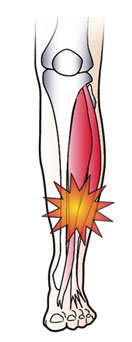Shin Splints: What You Need to Know for Prevention and Treatment
by footminders on Jun 15, 2009
 People who regularly exercise or play organized sports are at risk for shin splints, knee pain, Achilles tendonitis, and other lower body injuries. Medial tibial stress syndrome, as shin splints are referred to by the Mayo Clinic, is a pain that runs down the length of the shin bone and is caused by too much stress on the bones, muscles, and ligaments of the lower part of the leg. This stress is caused by running activities in any setting and can be aggravated by flat feet and insufficient foot arch support.
People who regularly exercise or play organized sports are at risk for shin splints, knee pain, Achilles tendonitis, and other lower body injuries. Medial tibial stress syndrome, as shin splints are referred to by the Mayo Clinic, is a pain that runs down the length of the shin bone and is caused by too much stress on the bones, muscles, and ligaments of the lower part of the leg. This stress is caused by running activities in any setting and can be aggravated by flat feet and insufficient foot arch support.
Leading sports therapy experts advise using ice, temporarily ceasing running or sports, and wearing shoes that fit better, preferably with the use of sports insoles. Putting ice on the shin and supporting structures of the lower leg help relieve pain while lessening the amount of swelling promptly after an injury. Relaxation is always advised because it allows for the bones, tendons and muscles to repair themselves. Finally, using better-fitting shoes can radically help avoid re-injuring the lower legs and feet by providing sufficient cushioning and support for the arches. This encourages correct foot alignment and absorbs shock. Sports insoles can significantly enhance endurance and performance because they provide support for the foot arches as well as extra cushioning. For people with flat feet, these specialized sports insoles lift the arch ideally and rebalance the lower body.
Over-pronation caused by flat feet can cause more than just shin splints to occur. Heel spurs and plantar fasciitis, ankle, knee, and low back pain, as well as Achilles tendonitis can be caused by flat feet. If sports insoles are not worn during physically stressful activities, re-injury and serious foot issues can occur. The mechanics involved in these injuries are related to the plantar fascia tendon, which is the central structure involved in the arch of the foot. It is a band-like structure that stretches to absorb the shock produced when the foot bears weight during activity. In people with flat feet, this tissue has been over-stretched and has lost its elasticity. Its ability to absorb shock has disappeared. This condition also causes overpronation of the foot, or the propensity for the ankles to roll toward the center of the body. As a result, the weight of the body is incorrectly centered on one area rather than being uniformly distributed over the full area of the foot. This is the reason why orthotics for sports can be of significant help in cases of flat feet and other foot problems; they provide structural stability and cushioning in the proper spots.
The post Shin Splints: What You Need to Know for Prevention and Treatment appeared first on .




